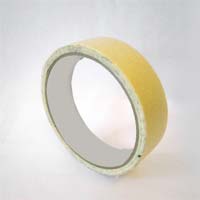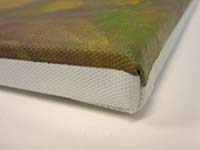| Glossary Of Giclee Terms
[11] |
M
Magenta Magenta is a primary color in the subtractive color model, along with cyan and yellow. Magenta is one of the three primary colors used in color printing and reproduction processes, such as CMYK printing, where it serves as one of the ink colors used to create a wide range of colors and hues. Magenta is a purplish-red color with a dominant hue that lies between red and blue on the color wheel. Magenta is commonly used in color printing to reproduce a variety of colors, including reds, purples, pinks, and blues, by mixing different combinations of cyan, magenta, yellow, and black inks or toners. |
Masking tape A pressure sensitive, self adhesive that is easy to tear and generally cream or white in color. It is available in various widths and is popular for protecting areas adjacent to those to be painted, due to its ease of removal. Various strengths are available, and are rated 1-100 based on the adhesion.
Order online: We offer various Tapes and Adhesives |
 |
| Matte Finish A non-glossy, "flat" finish that creates an even reflective surface with no glare. Matte paper is generally smooth in texture. |
Megapixel A megapixel is a unit of measurement used to quantify the resolution of digital images, representing one million pixels. It is commonly used to describe the resolution capability of digital cameras, camera sensors, and digital displays. The number of megapixels in an image indicates the total number of individual pixels that compose the image, with higher megapixel counts corresponding to higher image resolutions and potential for finer detail and larger print sizes.
For example, an image captured by a camera with a resolution of 12 megapixels contains approximately 12 million pixels, while an image captured by a camera with a resolution of 24 megapixels contains approximately 24 million pixels. The megapixel count alone does not determine image quality, as factors such as sensor size, pixel size, lens quality, and image processing also play significant roles. However, higher megapixel counts generally allow for greater flexibility in cropping, printing large-format images, and capturing finer details, particularly in situations where high-resolution output is desired. |
Memory Card A memory card is a portable storage device used to store digital data, such as photographs, videos, audio files, and documents. Memory cards are commonly used in digital cameras, camcorders, smartphones, tablets, and other electronic devices that require removable storage for capturing and storing multimedia content. Memory cards come in various formats and capacities, including Secure Digital (SD), CompactFlash (CF), microSD, Memory Stick, and others, each with its own physical size, storage capacity, and data transfer speed.
The storage capacity of memory cards ranges from a few gigabytes to several terabytes, allowing users to store thousands of photos, hours of video footage, and large data files. Memory cards are designed to be durable, shock-resistant, and capable of withstanding extreme temperatures and environmental conditions, making them suitable for use in demanding situations such as outdoor photography, sports photography, and professional videography. When choosing a memory card, factors to consider include storage capacity, data transfer speed, compatibility with the device, and reliability for long-term storage and data retention. Regular backup and proper handling of memory cards are essential to prevent data loss and ensure the integrity of stored digital content. |
| Metallic Paper Metallic paper is a type of printing paper with a metallic or pearlescent finish that imparts a subtle shimmer or metallic sheen to printed images. Metallic paper is coated with metallic pigments or reflective layers that enhance color saturation, contrast, and luminosity, giving images a unique, three-dimensional appearance with depth and vibrancy. Metallic paper is commonly used for high-end photography, fine art prints, luxury packaging, greeting cards, and marketing materials to create eye-catching, premium-quality reproductions. Metallic paper is available in various weights, surface textures, and finishes to suit different printing techniques and applications. |
Moiré Pattern A moiré pattern is an interference pattern that occurs when two sets of repetitive patterns, such as lines, grids, or textures, overlap or are slightly out of alignment with each other. Moiré patterns manifest as unwanted visual artifacts or shimmering effects in digital images, caused by the interaction between the repeating patterns in the subject and the grid-like arrangement of pixels on the camera sensor. Moiré patterns are more likely to occur when photographing subjects with fine, high-frequency textures or patterns, such as textiles, screens, or architectural details.
The appearance of moiré patterns can be minimized by adjusting the shooting angle, changing the distance from the subject, or using anti-aliasing filters in front of the camera sensor to blur fine details and reduce interference patterns. In post-processing, moiré patterns can be corrected using specialized software tools or by applying selective blurring or sharpening techniques to affected areas of the image. Understanding the causes and characteristics of moiré patterns is important for photographers to minimize their occurrence and preserve image quality in digital photography. |
Monochrome Monochrome refers to images that are composed of varying shades of a single color, typically black, white, or grayscale. In photography, monochrome images lack color information and are represented solely by variations in brightness and contrast. Monochrome photography emphasizes shape, form, texture, and tonality, allowing photographers to convey mood, atmosphere, and emotion through the interplay of light and shadow.
Common techniques for creating monochrome images include converting color photographs to grayscale or shooting with black-and-white film. Monochrome images often evoke a timeless and classic aesthetic, and they are widely used in fine art photography, portrait photography, street photography, and documentary photography to capture the essence of a subject without the distraction of color. |
| Mottle Mottle refers to an uneven distribution or irregular pattern of color, tone, or texture in a surface or material, resulting in blotchy or speckled appearance. Mottling can occur naturally in organic materials, such as wood, stone, or marble, due to variations in grain, density, or mineral content. In printing and reproduction processes, mottling can occur when ink or pigment is inconsistently applied or absorbed by the substrate, resulting in areas of uneven color or density. Mottling can also occur in digital imaging due to compression artifacts, noise, or interpolation errors. In some cases, mottling may be intentional and used for artistic effect, while in others, it may be undesirable and corrected through adjustments in printing or image processing. |
Mounting Mounting refers to the process of attaching or securing a print, artwork, photograph, or other two-dimensional object onto a backing board, mat, frame, or display surface for presentation, protection, or preservation. Mounting techniques vary depending on the size, weight, and characteristics of the object being mounted, as well as the desired display method and aesthetic preferences.
Common mounting methods include dry mounting (using adhesives or heat to bond the print to a backing board), hinge mounting (attaching the print to a mat or backing board using archival hinges), float mounting (suspending the print within a frame or display case), and pressure-sensitive mounting (using adhesive sheets or tapes to adhere the print to a substrate). Proper mounting ensures that prints are securely held in place, flat, and protected from damage or deterioration over time. |
Museum Wrap While "gallery wrap" refers simply to the process of wrapping a canvas all the way around the stretcher bar frame and affixing it to the back, "Museum wrap" refers to the color on the drop edges (sides) of the canvas). In a museum wrap, the entire image is confined to the front of the canvas, and the sides are a solid color or white. This may be due to canvases in museums and galleries generally being frames, so the edges were never visible.
There appears to be some disagreement about whether museum wrap is limited to canvases wrapped on 1 1/2" in stretcher bars, or if the depth of the bar does not matter for the designation. |
 |
|
© 2002-2024 - KeenART Media Ltd.
|
|
| |
|

